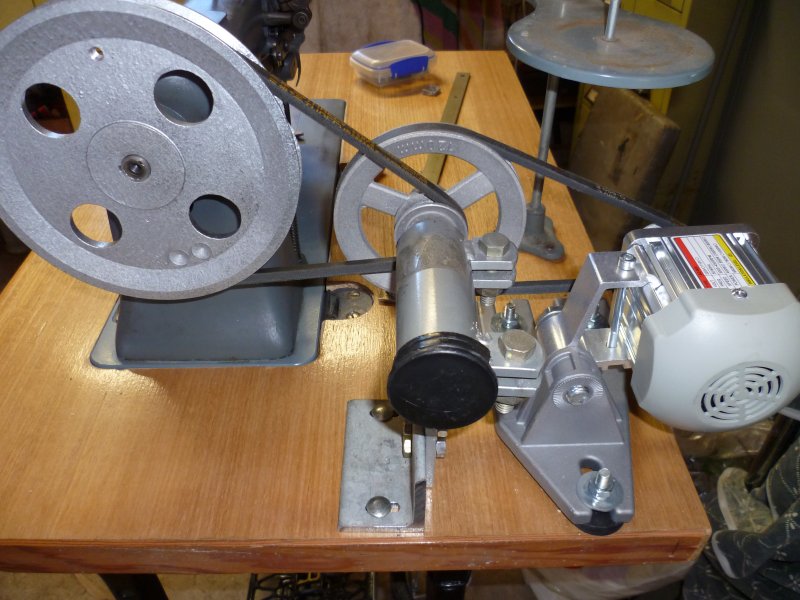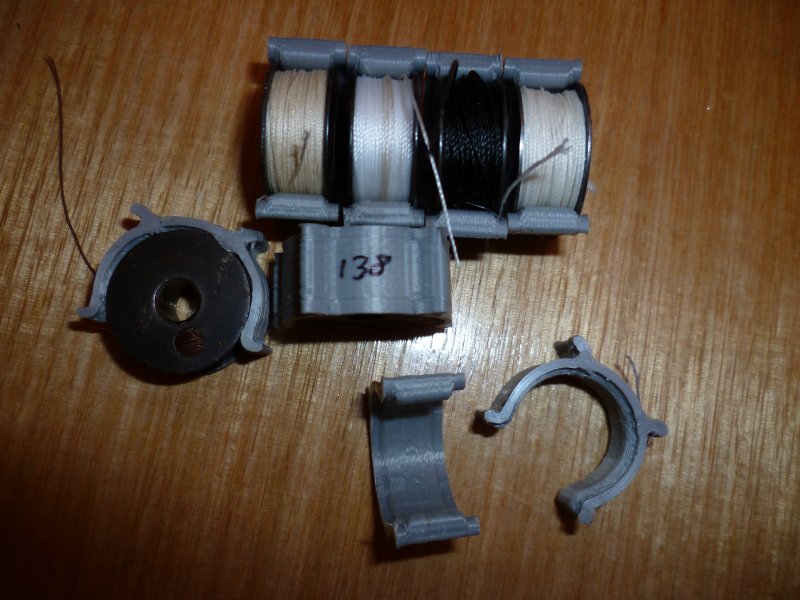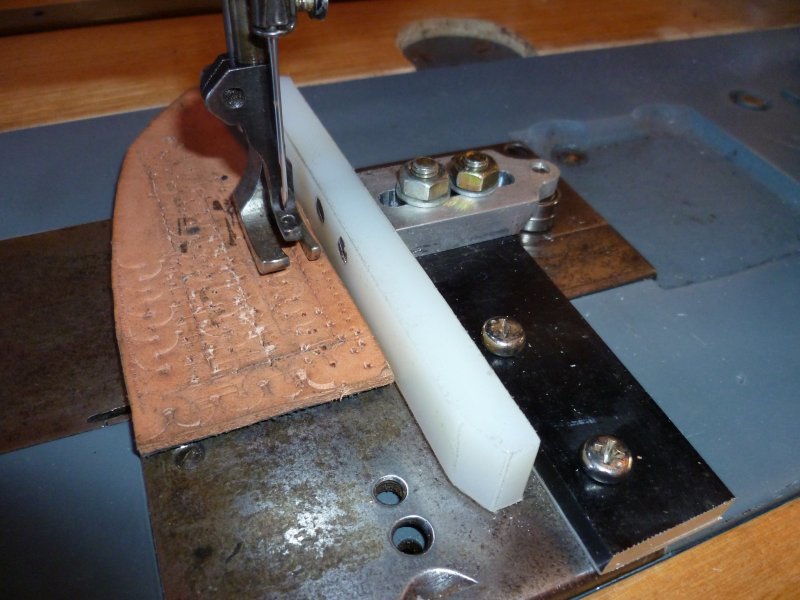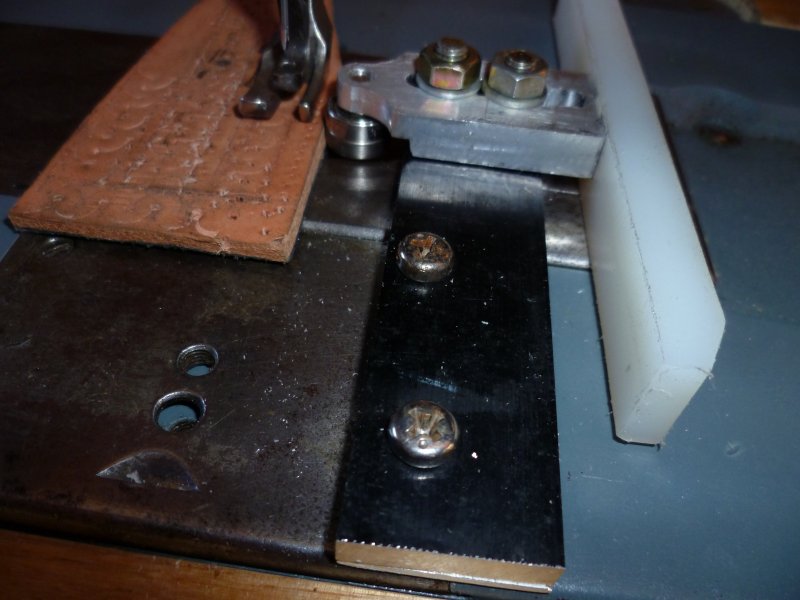-
Posts
4,808 -
Joined
-
Last visited
Content Type
Profiles
Forums
Events
Blogs
Gallery
Everything posted by dikman
-
There must be quite a story about how they all came to be there, pity we'll never know.
-

Sunstar km-380 cylinder arm machine
dikman replied to davehorseblanket's topic in Leather Sewing Machines
R8R, I have got my old model 335 to sew with #138 thread, but it's definitely happier with #69. I reckon #92 would be a pretty good compromise and should work ok. -
Mais oui, monsieur.
-

Pfaff 138-6 Looking for price and parts help
dikman replied to Scoutmom103's topic in Leather Sewing Machines
You've got a good eye, Don. When I looked closer the take-up spring looks a bit funny too and, strangely enough, most of the red paint marking oiling points appears to be intact. I suppose if you don't put oil down them then the paint won't be affected! I would say that the needle plate screw isn't original and is just a countersunk screw with a slightly larger head. The other one appears to be slightly domed, whereas this one is flat. And there appears to be another knurled nut just behind the cross-threaded tension nut? -

cobra sewing machine Cobra C3 - Thread options?
dikman replied to entropie's topic in Leather Sewing Machines
Wiz, I'd say that I've got a greater chance of winning the Lotto than finding something like that here in Oz!- 13 replies
-
- braided plyester
- nylon thread
- (and 7 more)
-

cobra sewing machine Cobra C3 - Thread options?
dikman replied to entropie's topic in Leather Sewing Machines
Yeah, it just bugs me that I can only use this thread for handstitching.- 13 replies
-
- braided plyester
- nylon thread
- (and 7 more)
-
On to Version 3. While it would turn over at fairly low speed it didn't matter how I played with the settings the transition from slow to fast (whatever I'd set the max to) was just to quick for my liking. So the only answer was to resurrect one of my reducers and modify it fit this setup. Fortunately I had a few short belts that would work and a goodly assortment of pulleys. It actually works quite well now. From the motor to the reducer gives me a 2.7:1 reduction and from the reducer to the head another 3.9:1. I can now sew at 1 stitch/2.5 secs and changing the max speed is simple, two buttons on the front of the control box if I need a faster top speed. Wonder what I can do next?
-

cobra sewing machine Cobra C3 - Thread options?
dikman replied to entropie's topic in Leather Sewing Machines
My experiences with using wax (beeswax, tallow, candle wax) in shooting and reloading is that once you get wax on something it's almost impossible to remove it completely! So while I'll happily use it to buff leather and seal the edges it isn't going anywhere near my needles!! I'll stick to "conventional" thread.- 13 replies
-
- braided plyester
- nylon thread
- (and 7 more)
-

cobra sewing machine Cobra C3 - Thread options?
dikman replied to entropie's topic in Leather Sewing Machines
Matt, it's dry. Maybe it has to be run through a wax or silicone bath while sewing? Too messy to try and I definitely don't want wax gumming things up.- 13 replies
-
- braided plyester
- nylon thread
- (and 7 more)
-

cobra sewing machine Cobra C3 - Thread options?
dikman replied to entropie's topic in Leather Sewing Machines
For what it's worth - I have some braided polyester thread (#69) that came from a closing down boot factory. It's beautiful thread, but so far I haven't been able to use it successfully in any of my machines (an assortment of medium-weight upholstery machines). At some point the hook inevitably catches in the braid and I don't know why. I've no idea what machines used it in the factory. By the way, you're not the first person to want to use their hand-stitching thread in a machine and thus far I'm not aware of anyone who has. Maybe you'll be the first?- 13 replies
-
- braided plyester
- nylon thread
- (and 7 more)
-
You have a way with words, Wiz. My latest servo doesn't have the smooth (slow) transition from start to max movement that my others have (different brand). I figure it's probably due to the design in the way it interprets the signal from the Hall Effect sensor, so not much I can do about it (other than mess around with additional pulley reducers). When you try a different brand it's pot luck whether it will perform how you would like it to.
-
I keep 1/2 dozen spools with the 117 and as they are kept in a small container they keep unwinding! I looked on Thingiverse and found three types of bobbin clip, this one seems the best. Fits Singer 111/211 type bobbins, but will stretch a little to fit some others. They stand upright and I can write the thread size on the clip (so I don't get confused). They work fine in PLA but a springier filament would probably be better (nylon?). Improved_Sewing_Bobbin_Clip.zip
-
Now that my 111W117 is functional I figured I'd need a guide of some sort for belts etc. As the front plate has a few screw holes already in it (for who-knows-what accessories) I decided it would make sense to use them. I eventually worked out that they were tapped Metric, most surprising for a machine made in the US probably decades ago. This is the result, bearings from a junked hard disc drive, long guide machined from a piece of round hard nylon and assorted scrap. Hopefully it should work.
-

oops I did it again as the song goes - Singer 29Kxx
dikman replied to plinkercases's topic in Leather Sewing Machines
Nice one! Trouble is it's pretty hard to stop when a bargain comes along. -

Pfaff 138-6 Looking for price and parts help
dikman replied to Scoutmom103's topic in Leather Sewing Machines
I'm with R8R. If you must pay something $5 and salvage whatever parts you can (screws etc). That is bad. -
What a load of garbage!! Whoever you spoke to has no idea what they're talking about.
-

What should I look for on a used Juki LU-563?
dikman replied to LederMaschinist's topic in Leather Sewing Machines
If it's the original owner then I think you're off to a good start. I can't add much other than agree that turning it over by hand, listening and feeling for anything that doesn't seem right and checking that it stitches is a good idea. -

**NEED HELP** Consew Con-Serv E6 error
dikman replied to DS STRAPS's topic in Leather Sewing Machines
Do you have any paperwork for the servo? It should show you how to change a setting to turn off the positioner, unless you actually want to use it in which case yes, you have to plug it in.. -
I've made this post as a link to a previous post about 3D printing pulleys (took me a while to find it last time I went looking).
-
If you definitely need the binder then I guess the 335 is the logical choice, but other than the binder the 227 is the superior machine for leatherwork, in my opinion. It also handles heavier thread.
-

Cowboy 3200 foot impressions.....help needed
dikman replied to kyleatherworker's topic in Leather Sewing Machines
Best thing to do is try it. If it doesn't work just move it back. -

Looking for help in identifying this Singer
dikman replied to STARSTITCHED's topic in Leather Sewing Machines
Except for W and SV models. -
If you've got the clearance then try shimming under where the foot attaches to the main bar (under the two screws). As long as it doesn't scrape on anything it should be fine. It's the same attachment method as the Pfaff 335 and there's no vertical adjustment.
-
It should go under that check spring (wire loop),






